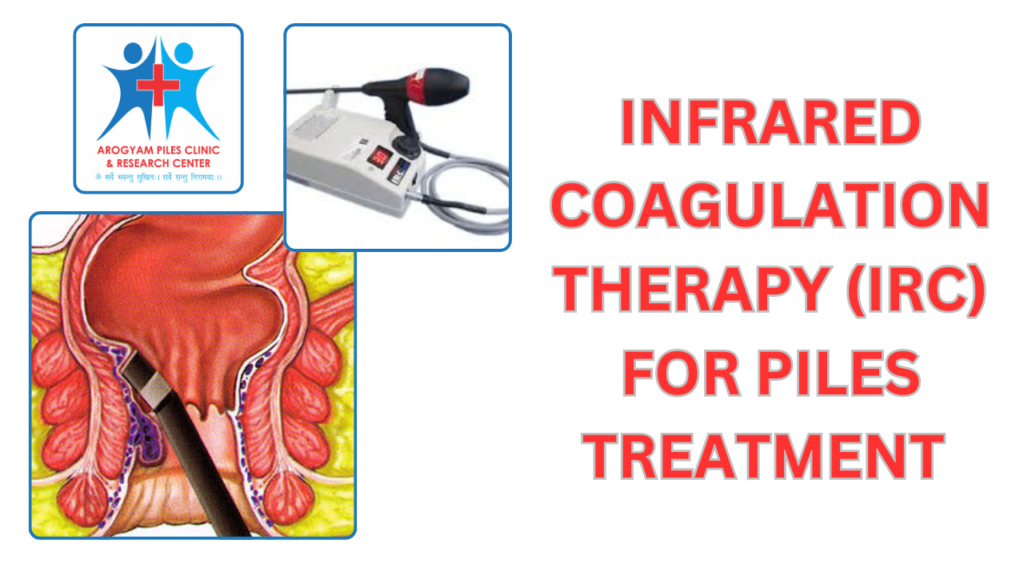
Piles, also known as hemorrhoids, are a common condition that affects millions of people worldwide. They occur when the blood vessels in the rectal area become swollen and inflamed, causing discomfort, pain, and sometimes bleeding. While there are various treatment options available for piles, one effective and minimally invasive procedure is infrared coagulation (IRC) treatment.
What is Infrared Coagulation Treatment?
Infrared coagulation treatment, also referred to as infrared photocoagulation, is a medical procedure used to treat internal hemorrhoids. It involves the use of infrared light to coagulate the blood vessels within the hemorrhoids, causing them to shrink and eventually disappear. During the IRC procedure, a small probe is inserted into the rectum, and infrared light is directed towards the hemorrhoidal tissue. This light generates heat, which causes the blood vessels to coagulate and form scar tissue. Over time, the scar tissue helps to hold the hemorrhoids in place, reducing their size and symptoms.
Procedure of Infrared Coagulation Treatment:
- Preparation: Before the procedure, the patient may be advised to follow certain instructions, such as fasting for a few hours and taking laxatives or enemas to empty the bowels.
- Positioning: The patient is positioned comfortably on a table, usually lying on their side with knees bent towards the chest.
- Anesthesia: Infrared coagulation is typically performed without anesthesia, as it is a relatively painless procedure. However, if the patient experiences discomfort, a local anesthetic cream or gel may be applied to the anal area.
- Insertion of probe: The doctor gently inserts a small probe into the rectum. The probe emits infrared light, which is directed towards the internal hemorrhoids.
- Treatment: The doctor applies the infrared light to the hemorrhoidal tissue in short bursts. The heat generated by the light causes the blood vessels to coagulate, effectively cutting off the blood supply to the hemorrhoids.
- Multiple sessions: Depending on the severity of the condition, multiple treatment sessions may be required, typically spaced a few weeks apart. This allows for optimal healing and reduction of hemorrhoids.
- Recovery: After the procedure, patients can usually resume their normal activities immediately. Some may experience minor discomfort or a feeling of fullness in the rectal area, but this typically subsides within a day or two.
Benefits of Infrared Coagulation Treatment:
- Minimally invasive: IRC is a non-surgical procedure that does not involve any incisions. It is performed on an outpatient basis, and patients can return home on the same day.
- Quick and Convenient: The procedure usually takes only a few minutes to perform, making it a convenient option for individuals with busy schedules.
- Virtually painless: IRC treatment is generally well-tolerated by patients and causes minimal pain or discomfort. Anesthesia is usually not required, and recovery is relatively quick.
- High success rate: Infrared coagulation has shown high success rates in treating internal hemorrhoids, with studies reporting significant improvement in symptoms and reduction in hemorrhoid size.
- Fewer complications: Compared to traditional surgical procedures for hemorrhoids, such as hemorrhoidectomy, IRC has a lower risk of complications such as bleeding, infection, and anal stenosis.
Drawbacks of Infrared Coagulation Treatment:
- May require multiple sessions: While IRC treatment is effective, some patients may require multiple treatment sessions to achieve optimal results. The number of sessions depends on the severity of the hemorrhoids and the individual’s response to treatment.
- Possible recurrence: Infrared coagulation can effectively shrink existing hemorrhoids, but it does not guarantee permanent removal. In some cases, new hemorrhoids may develop over time or existing ones may reoccur.
- Limited effectiveness for external hemorrhoids: IRC is primarily used for the treatment of internal hemorrhoids. It may not be as effective for external hemorrhoids that are located outside the anal opening.
- Potential side effects: Although rare, some individuals may experience mild side effects after IRC treatment, such as minor bleeding, temporary anal discomfort, or a feeling of urgency to have a bowel movement.
- Not suitable for all cases: Infrared coagulation may not be suitable for individuals with certain medical conditions or those who have severe hemorrhoids that require more extensive treatment options.
Conclusion:
Infrared coagulation treatment is a safe and effective option for managing internal hemorrhoids. It offers several benefits, including minimal invasiveness, quick recovery, and high success rates. However, like any medical procedure, it has its drawbacks and limitations. It is important to consult with a qualified healthcare professional to determine if IRC treatment is appropriate for your specific condition.
Remember, this blog is for informational purposes only and should not be considered medical advice. If you are looking for Piles specialist doctor in Chandigarh then you can fix your appointment with specialist at Arogyam Piles Clinic and Research Center located in Mohali, Chandigarh by visiting official website www.arogyampilesclinic.com or directly call +91 96467 64444.



